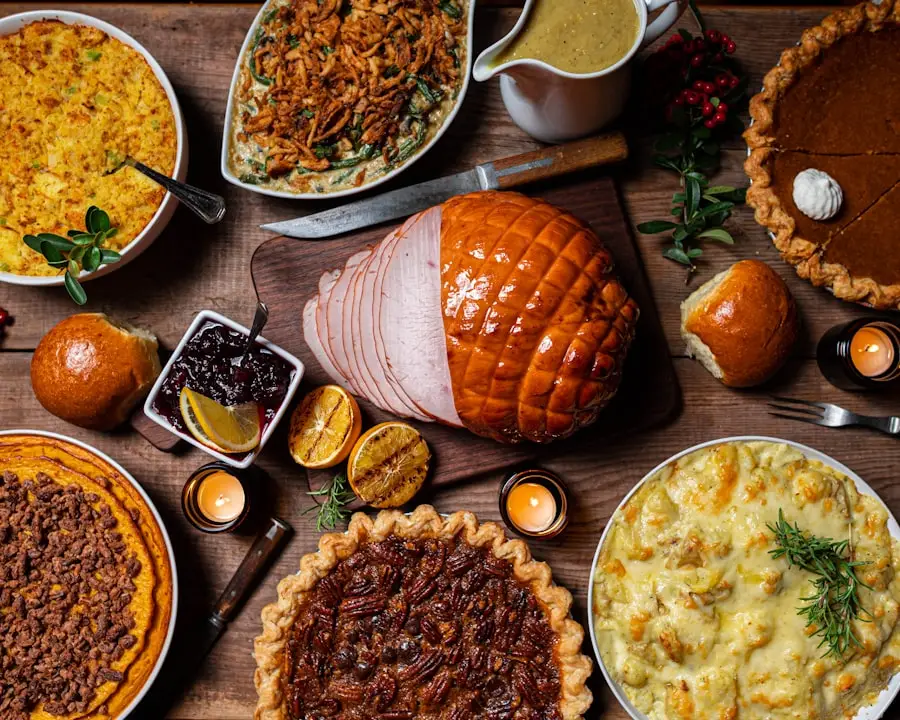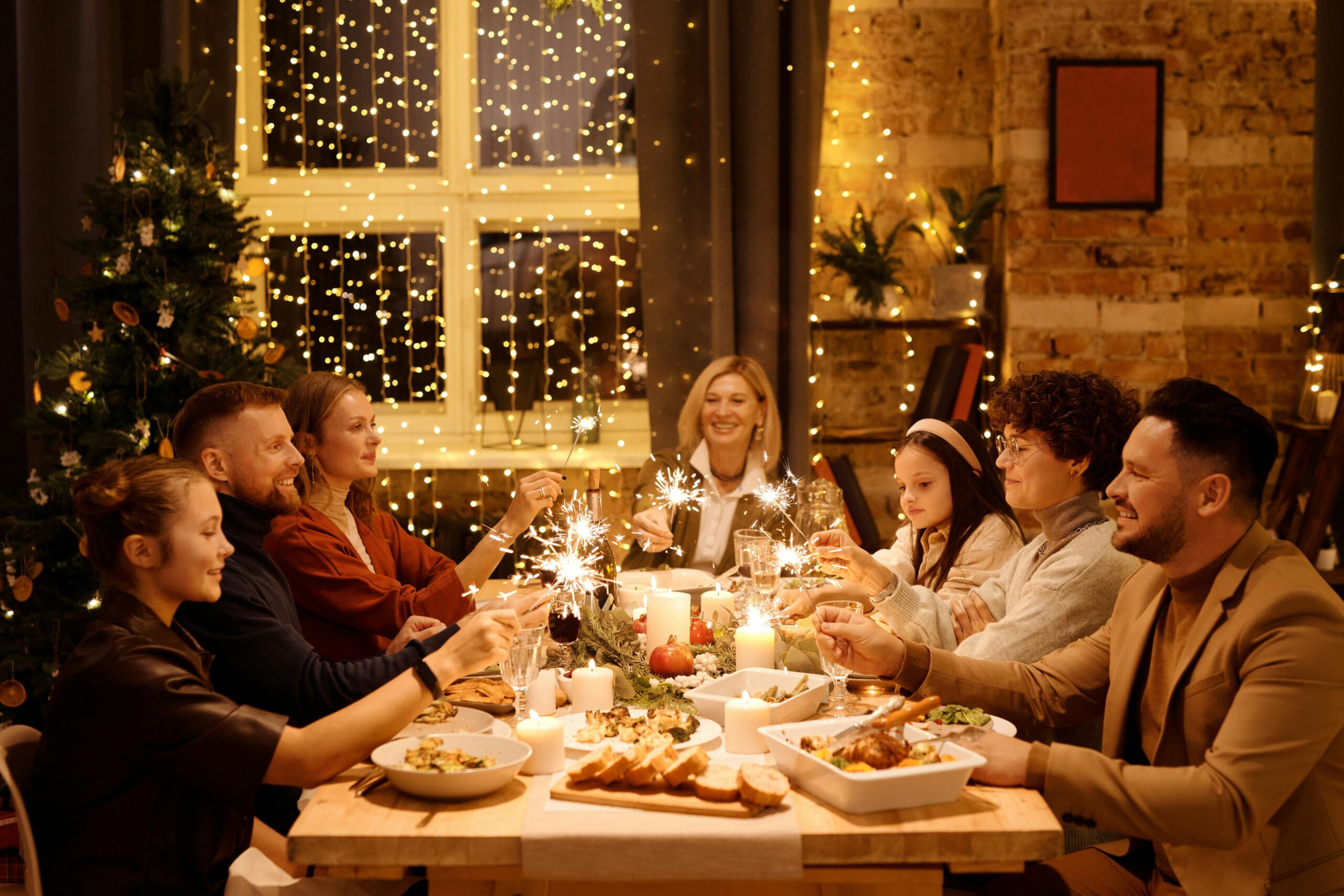The traditional English Christmas dinner has a rich and varied history that reflects the evolution of British society and its culinary practices. Dating back to the Middle Ages, the festive meal was originally a time for feasting and celebration, often featuring a variety of meats, pies, and seasonal vegetables. The earliest records suggest that the Christmas feast was a way to mark the end of the harvest season, allowing families to indulge in the bounty of their hard work.
Over the centuries, as customs and ingredients changed, so too did the nature of the Christmas dinner, evolving into the beloved tradition we know today. By the Victorian era, the Christmas dinner had taken on a more defined structure, with roast turkey emerging as the star of the show. This shift was largely influenced by Queen Victoria and Prince Albert, who popularised many German traditions, including the Christmas tree and festive feasting.
The turkey became a symbol of abundance and celebration, gradually replacing the traditional goose that had been served for centuries. Today, the English Christmas dinner is a cherished occasion that brings families together, steeped in nostalgia and culinary heritage.
Summary
- The traditional English Christmas dinner has evolved over centuries, with roast turkey becoming the central dish in the Victorian era.
- Roast turkey is typically served with classic trimmings such as stuffing, roast potatoes, and Brussels sprouts.
- Popular sides include cranberry sauce, pigs in blankets, and rich gravy to complement the main course.
- Festive desserts often feature Christmas pudding, mince pies, and brandy butter, with vegan alternatives now widely available.
- Setting the perfect table involves festive decorations, elegant crockery, and traditional Christmas crackers to enhance the celebratory atmosphere.
The Main Course: Roast Turkey with all the Trimmings
At the heart of any traditional English Christmas dinner lies the roast turkey, a majestic bird that takes centre stage on the dining table. The preparation of this festive main course is an art in itself, requiring careful attention to detail to ensure it is succulent and flavourful. A well-cooked turkey should have golden-brown skin that is crisp to the bite, while the meat remains juicy and tender.
Many families have their own secret recipes for brining or seasoning their turkey, often incorporating herbs like thyme and rosemary to enhance its natural flavours. Accompanying the turkey are the all-important trimmings, which elevate this dish to a true feast. From crispy roast potatoes to fluffy Yorkshire puddings, each element plays a vital role in creating a harmonious meal.
The rich gravy, made from the pan drippings, adds depth and moisture to each bite, while cranberry sauce provides a delightful contrast with its tartness. The combination of flavours and textures creates a memorable dining experience that is eagerly anticipated each year.
Traditional Sides and Accompaniments for a Christmas Dinner

No Christmas dinner would be complete without an array of traditional sides that complement the main course beautifully. Among these, roast potatoes are perhaps the most iconic; their crispy exterior and fluffy interior make them a favourite among diners of all ages. Parboiling them before roasting ensures they achieve that perfect crunch, while a drizzle of goose fat or olive oil adds an extra layer of flavour.
Brussels sprouts are another staple side dish that often garners mixed reviews. However, when cooked properly—perhaps sautéed with chestnuts or glazed with balsamic vinegar—they can be transformed into a delightful addition to the festive table. Carrots and parsnips, roasted until caramelised, provide a sweet contrast to the savoury elements of the meal.
Additionally, stuffing balls or sage and onion stuffing are essential accompaniments that add both flavour and texture to the plate.
Desserts and Sweets for a Festive Feast
As the main course comes to an end, anticipation builds for the grand finale: dessert. Traditional English Christmas desserts are often rich and indulgent, reflecting the celebratory nature of the occasion. The classic Christmas pudding is perhaps the most iconic sweet treat associated with this festive season.
Made with a mixture of dried fruits, spices, and often a splash of brandy, this dense pudding is steamed to perfection and traditionally served with a sprig of holly on top. The ritual of setting it alight before serving adds an element of theatre that delights guests. Another beloved dessert is the mince pie, filled with a spiced mixture of dried fruits and nuts encased in buttery pastry.
These little pies are often enjoyed warm with a dollop of cream or custard. For those seeking something lighter, trifle—a layered dessert made with sponge cake, custard, fruit, and whipped cream—offers a refreshing end to the meal. Each dessert not only satisfies sweet cravings but also embodies the warmth and joy of sharing festive moments with loved ones.
Vegetarian and Vegan Options for a Traditional Christmas Dinner
In recent years, there has been a significant shift towards accommodating dietary preferences and restrictions during festive meals. As more people embrace vegetarianism or veganism, traditional Christmas dinners have evolved to include delicious plant-based options that do not compromise on flavour or festivity. A nut roast has become a popular alternative to turkey; packed with nuts, seeds, vegetables, and herbs, it offers a hearty and satisfying main course that can be enjoyed by all.
For those following a vegan diet, there are numerous creative options available. A stuffed squash or pumpkin can serve as an impressive centrepiece, filled with grains, nuts, and seasonal vegetables. Additionally, many recipes now feature plant-based versions of classic sides such as creamy mashed potatoes made with almond milk or vegan gravy crafted from mushrooms and vegetable stock.
These dishes not only cater to dietary needs but also showcase the versatility of plant-based cooking during this festive season.
Tips and Tricks for Cooking a Perfect Christmas Dinner

Cooking a perfect Christmas dinner can be both exhilarating and daunting; however, with careful planning and organisation, it can be an enjoyable experience for all involved. One essential tip is to create a detailed timeline leading up to the big day. This should include when to start preparing each dish, allowing ample time for marinating or resting where necessary.
Preparing certain elements in advance—such as making gravy or dessert—can alleviate stress on Christmas Day itself. Another crucial aspect is ensuring that your kitchen is well-equipped for the task at hand. Having sharp knives, sturdy roasting trays, and reliable thermometers can make all the difference in achieving culinary success.
Don’t forget about presentation; taking time to arrange your dishes beautifully can elevate your meal from ordinary to extraordinary. Finally, remember to enjoy the process; cooking for loved ones is a labour of love that should be savoured as much as the meal itself.
Traditional Drinks and Beverages to Accompany the Feast
No festive meal is complete without an array of drinks to complement the food and enhance the celebratory atmosphere. Traditional beverages such as mulled wine are synonymous with Christmas; this warming concoction of red wine infused with spices like cinnamon and cloves creates an inviting aroma that fills the home during winter gatherings. Served warm in festive mugs or glasses, it sets the tone for an evening filled with cheer.
For those who prefer something non-alcoholic, spiced apple cider or homemade cranberry punch can provide equally delightful alternatives. Additionally, sparkling water or soft drinks can help cleanse the palate between courses. As dinner progresses into dessert, consider serving sweet dessert wines or even a rich port to pair beautifully with your festive sweets.
The right beverages not only enhance flavours but also contribute to creating lasting memories around the table.
How to Set the Perfect Table for a Traditional English Christmas Dinner
Setting the table for a traditional English Christmas dinner is an opportunity to showcase your personal style while embracing festive cheer. Start by selecting a beautiful tablecloth or runner that reflects the season—think rich reds or greens adorned with subtle patterns or textures. Layering your tableware adds depth; consider using charger plates beneath your dinner plates for an elegant touch.
When it comes to cutlery and glassware, ensure everything is polished and arranged neatly for each guest. A well-set table should include all necessary utensils for each course while maintaining an inviting atmosphere. Don’t forget about centrepieces; fresh flowers or seasonal decorations like holly or pinecones can add warmth and charm to your dining experience.
Finally, consider placing small personalised name cards at each setting; this thoughtful gesture not only makes guests feel special but also adds an extra layer of festivity to your gathering. In conclusion, crafting a traditional English Christmas dinner is about more than just food; it’s about creating cherished memories with family and friends around a beautifully set table filled with love and laughter. From understanding its historical roots to mastering each dish’s preparation and presentation, every aspect contributes to making this festive occasion truly special.
Whether you’re sticking to tradition or exploring new culinary avenues, embracing this time-honoured celebration will undoubtedly bring joy to your holiday season.
FAQs
What is typically included in a traditional English Christmas dinner?
A traditional English Christmas dinner usually features roast turkey as the main dish, accompanied by roast potatoes, Brussels sprouts, parsnips, carrots, and sometimes peas. It is often served with stuffing, pigs in blankets (sausages wrapped in bacon), cranberry sauce, and rich gravy.
What are pigs in blankets?
Pigs in blankets are small sausages wrapped in bacon, commonly served as a side dish during Christmas dinner in England. They are typically roasted alongside the turkey.
How is the turkey prepared for Christmas dinner?
The turkey is usually seasoned and stuffed with a mixture of breadcrumbs, herbs, and sometimes sausage meat. It is then roasted in the oven until the skin is golden and the meat is cooked through.
What are common vegetables served with a traditional English Christmas dinner?
Common vegetables include Brussels sprouts, roast parsnips, carrots, and roast potatoes. Some families also include peas or cauliflower cheese.
What is the traditional dessert after an English Christmas dinner?
The traditional dessert is Christmas pudding, a rich, steamed fruit cake often served with brandy butter, cream, or custard. Mince pies are also popular during the festive season.
Is gravy an essential part of the Christmas dinner?
Yes, gravy made from the turkey drippings is an essential accompaniment, adding flavour and moisture to the meal.
Are there any regional variations in the traditional English Christmas dinner?
Yes, some regions may include additional dishes such as game meats, different types of stuffing, or regional vegetables. However, roast turkey with the classic sides remains the most common.
When is the traditional English Christmas dinner served?
It is traditionally served on Christmas Day, usually in the early afternoon, following the opening of presents in the morning.



